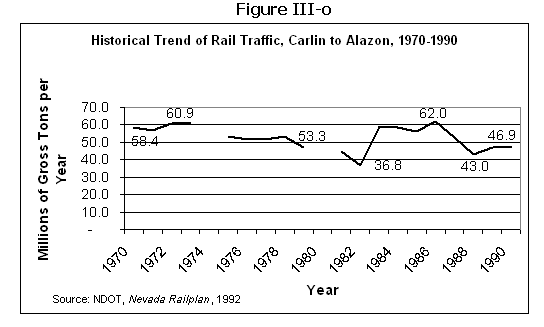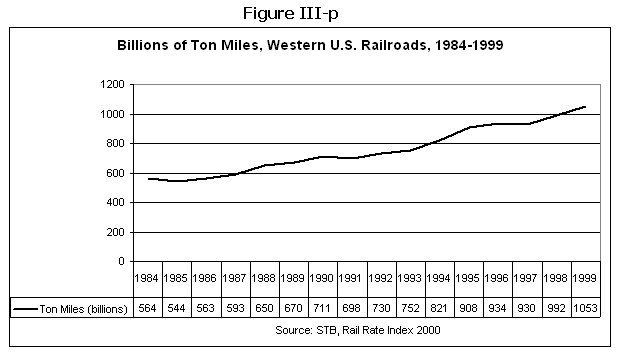

D. CURRENT AND HISTORICAL TRAIN FREQUENCY
Current (2003) Train Frequencies
 n 2003, Union Pacific dual tracks through the Eureka County study area carried 27 trains per day, with the average tonnage of each train between 5,000 and 6,999 tons. The train-per-day statistics do not differentiate between types of trains. For example, a light helper engine returning from helping a heavy coal train to the top of a grade counts the same as the coal train in these statistics, despite the huge difference between them in tonnage. In addition, two Amtrak passenger trains per day pass through the study area, a westbound California Zephyr train leaves Elko at 3:21 a.m. and arrives in Winnemucca at 6:13 a.m., and an eastbound California Zephyr leaves Winnemucca at 7:05 p.m., arriving in Elko at 9:40 p.m. n 2003, Union Pacific dual tracks through the Eureka County study area carried 27 trains per day, with the average tonnage of each train between 5,000 and 6,999 tons. The train-per-day statistics do not differentiate between types of trains. For example, a light helper engine returning from helping a heavy coal train to the top of a grade counts the same as the coal train in these statistics, despite the huge difference between them in tonnage. In addition, two Amtrak passenger trains per day pass through the study area, a westbound California Zephyr train leaves Elko at 3:21 a.m. and arrives in Winnemucca at 6:13 a.m., and an eastbound California Zephyr leaves Winnemucca at 7:05 p.m., arriving in Elko at 9:40 p.m.
The density map in Union Pacific's 2004 Analyst Fact book shows the dual tracks through northern Nevada each receiving 49 million gross tons per mile or less. The number of trains per day has not changed significantly since 2000. (Trains Magazine, 2004)
Historical Train Frequencies
Information regarding historical trends in rail traffic along the northern Nevada route between 1970 and 1990 was obtained from the Nevada Railplan (NDOT, 1992) and reproduced in Figure III- n, below. As this graph shows, gross tons per year along the route were at a high of around 61 million tons per year in 1972-1974, dropped to a low of 36.8 million tons in 1982 (this is the year UP purchased WP) , rose to another high of 62 million tons in 1986, and fell again in the late 1980's.

NDOT did not produce rail plans showing historical railroad traffic in the 1990s to the early 2000's, and information on historic rail traffic in these years has proved difficult to obtain. Repeated calls and emails to Union Pacific contacts asking for information regarding historical train frequencies through the study area were not returned. Density maps on the Union Pacific Corporation website do show gross tonnage for the dual lines passing through the County in 2000-2004, but the data are aggregated in such a way that it is not possible to tell if there has been a change in ton miles on that portion of track during that time period: density maps for all four years show 49 million gross tons or less.
Data obtained from the Surface Transportation Board, shown in Figure III-p, below, show that overall rail ton-miles in the Western U.S. increased by 93% between 1984 and 1999. Ton-miles increased in all categories, but the biggest increase, and the largest category overall, was coal. This is probably due to the development of the Powder River Basin coal area in eastern Wyoming: the line from this area to routes accessing the East and Midwest is one of Union Pacific's busiest. This coal traffic, with the exception of trains bringing coal to the Valmy power plant, does not pass through the study area. Nonetheless, since all other categories of western rail ton-miles also increased, it is reasonable to assume that there was some increase in tonnage in the study area during the 1984-1999 time period.

|


